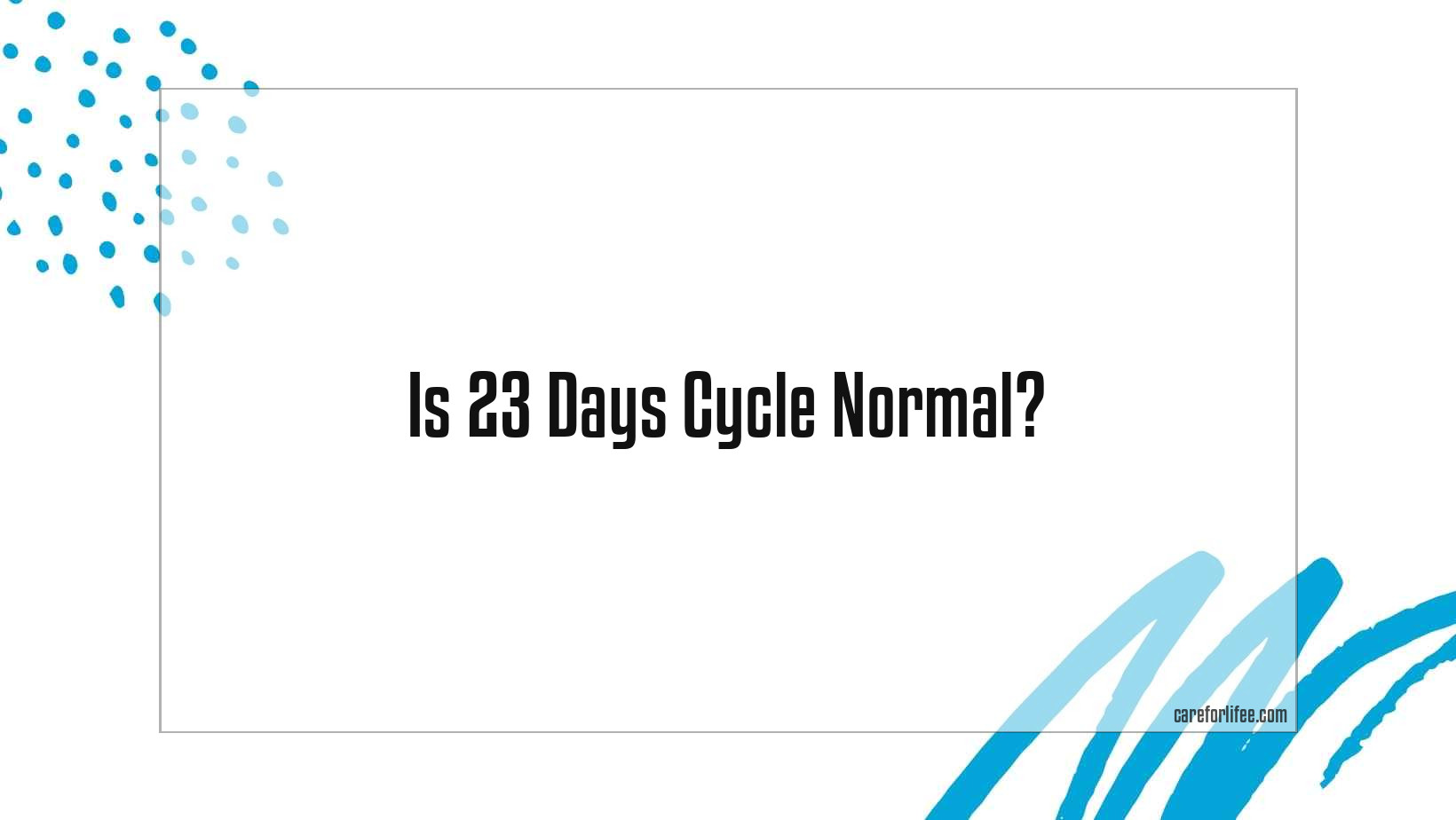Is 23 Days Cycle Normal
It’s normal to have a 23-day menstrual cycle, but it’s not the only normal. The average menstrual cycle is 28 days long, but it can range from 21 to 35 days. So, if your cycle is 23 days long, it’s considered within the normal range.
There are a number of factors that can affect your menstrual cycle, including stress, diet, exercise, and medications. If you’re concerned about your cycle length, talk to your doctor. They can help you determine if there’s anything abnormal about your cycle and help you find ways to manage any underlying conditions.
What Is The Average Length Of A Menstrual Cycle?

The menstrual cycle is the time from the first day of a woman’s period to the first day of her next period. The average menstrual cycle is 28 days long. However, it is normal for a woman’s cycle to be anywhere from 21 to 35 days long.
A woman’s menstrual cycle is controlled by hormones. These hormones cause the lining of the uterus (endometrium) to thicken in preparation for a possible pregnancy. If no pregnancy occurs, the endometrium is shed as the woman’s period.
The first day of bleeding is considered day one of the menstrual cycle. Bleeding usually lasts three to five days. The days of bleeding are called the “menses.”
The menstrual cycle is divided into two phases: the follicular phase and the luteal phase.
The follicular phase begins on day one of the menstrual cycle and lasts until ovulation. This phase is controlled by the hormone estrogen. Estrogen causes the endometrium to thicken and the ovaries to mature a follicle (a sac that contains an egg).
Ovulation usually occurs around day 14 of the menstrual cycle. It is the release of a mature egg from the ovary. The egg travels down the fallopian tube where it may be fertilized by a sperm.
The luteal phase begins after ovulation and lasts until the start of the next period. This phase is controlled by the hormone progesterone. Progesterone causes the endometrium to thicken even further in preparation for a possible pregnancy. If no pregnancy occurs, the endometrium is shed during the woman’s next period.
The length of the menstrual cycle can vary from woman to woman. However, most women have a cycle that is between 21 and 35 days long.
What Are The Normal Ranges For A Menstrual Cycle?
A menstrual cycle is the time between the first day of one period to the first day of the next period. Most women have cycles that are between 24 and 32 days long. If your cycle is shorter or longer than this, you may want to talk with your healthcare provider.
The menstrual cycle is controlled by hormones. These are chemicals that circulate in the blood and control many different body functions. The two main hormones that control the menstrual cycle are estrogen and progesterone.
Estrogen is produced by the ovaries and is important for the development of the egg. Progesterone is also produced by the ovaries and helps to prepare the lining of the uterus for pregnancy.
During the first half of the menstrual cycle, the level of estrogen in the blood rises. This causes the lining of the uterus to thicken. Around the middle of the cycle, an egg is released from one of the ovaries (ovulation).
After ovulation, the level of progesterone in the blood rises. This causes the lining of the uterus to thicken even more. If pregnancy does not occur, the level of progesterone falls and the lining of the uterus is shed. This is the menstrual period.
The menstrual cycle is a complex process that is controlled by many different hormones. If any of these hormones are out of balance, it can cause problems with the menstrual cycle.
For example, if the level of estrogen is too low, it can cause the lining of the uterus to become thin. This can make it difficult to get pregnant. If the level of progesterone is too low, it can cause the lining of the uterus to become thin and can also cause irregular bleeding.
There are many different things that can cause hormone levels to become out of balance. Some of these include:
• Stress
• Weight gain or loss
• Exercise
• Birth control pills
• Sickness
If you are having problems with your menstrual cycle, talk to your healthcare provider. He or she can help you find out if your hormone levels are out of balance and can offer treatment options.
What Factors Can Affect The Menstrual Cycle?
There are many different factors that can affect a woman’s menstrual cycle. Some of these factors can be out of our control, while others we may be able to change. Here are some of the most common factors that can affect your menstrual cycle:
1. Hormones: Hormones play a big role in regulating your menstrual cycle. If your hormones are out of balance, it can lead to irregular periods.
2. Stress: Stress can also disrupt your menstrual cycle. When you’re stressed, your body produces a hormone called cortisol. This hormone can interfere with other hormones in your body, leading to irregular periods.
3. Weight: Your weight can also affect your menstrual cycle. If you’re underweight or overweight, it can lead to irregular periods.
4. Exercise: Exercise can also be a factor in your menstrual cycle. If you exercise too much or too little, it can lead to irregular periods.
5. Medications: Certain medications can also affect your menstrual cycle. If you’re taking birth control pills, for example, it can lead to lighter or heavier periods.
6. Illness: illnesses can also cause your menstrual cycle to be disrupted. If you have a fever, for example, it can cause your period to be lighter than usual.
7. Age: Age can also play a role in your menstrual cycle. As you get older, your periods may become less regular.
These are just some of the factors that can affect your menstrual cycle. If you’re concerned about your menstrual cycle, talk to your doctor. They can help you determine if there’s anything you can do to help regulate it.
How Can I Tell If My Menstrual Cycle Is Abnormal?
It’s normal to have some variation in your menstrual cycle, but there are some signs that may indicate an abnormal cycle. Here are some things to look out for:
1. Menstrual bleeding that is much heavier or lasts longer than usual.
2. Menstrual bleeding that is lighter or shorter than usual.
3. Skipping periods or having periods that come more often than usual.
4. Changes in the timing of your period (starting earlier or later than usual).
5. Bleeding or spotting between periods.
6. Painful periods.
If you’re experiencing any of these changes, it’s important to see your doctor to rule out any underlying health conditions.
What Are The Treatments For Abnormal Menstrual Cycles?
There are many possible treatments for abnormal menstrual cycles, depending on the underlying cause. Some common treatments include:
-Hormonal birth control to regulate hormones and prevent ovulation
-Progestin therapy to thin the uterine lining and prevent overgrowth
-NSAIDs to reduce pain and inflammation
-Antidepressants to relieve PMS symptoms
If you are suffering from abnormal menstrual cycles, it is important to consult with your doctor to determine the best course of treatment for you.
If you’re still wondering if a 23 day cycle is normal, feel free to leave a comment below.







